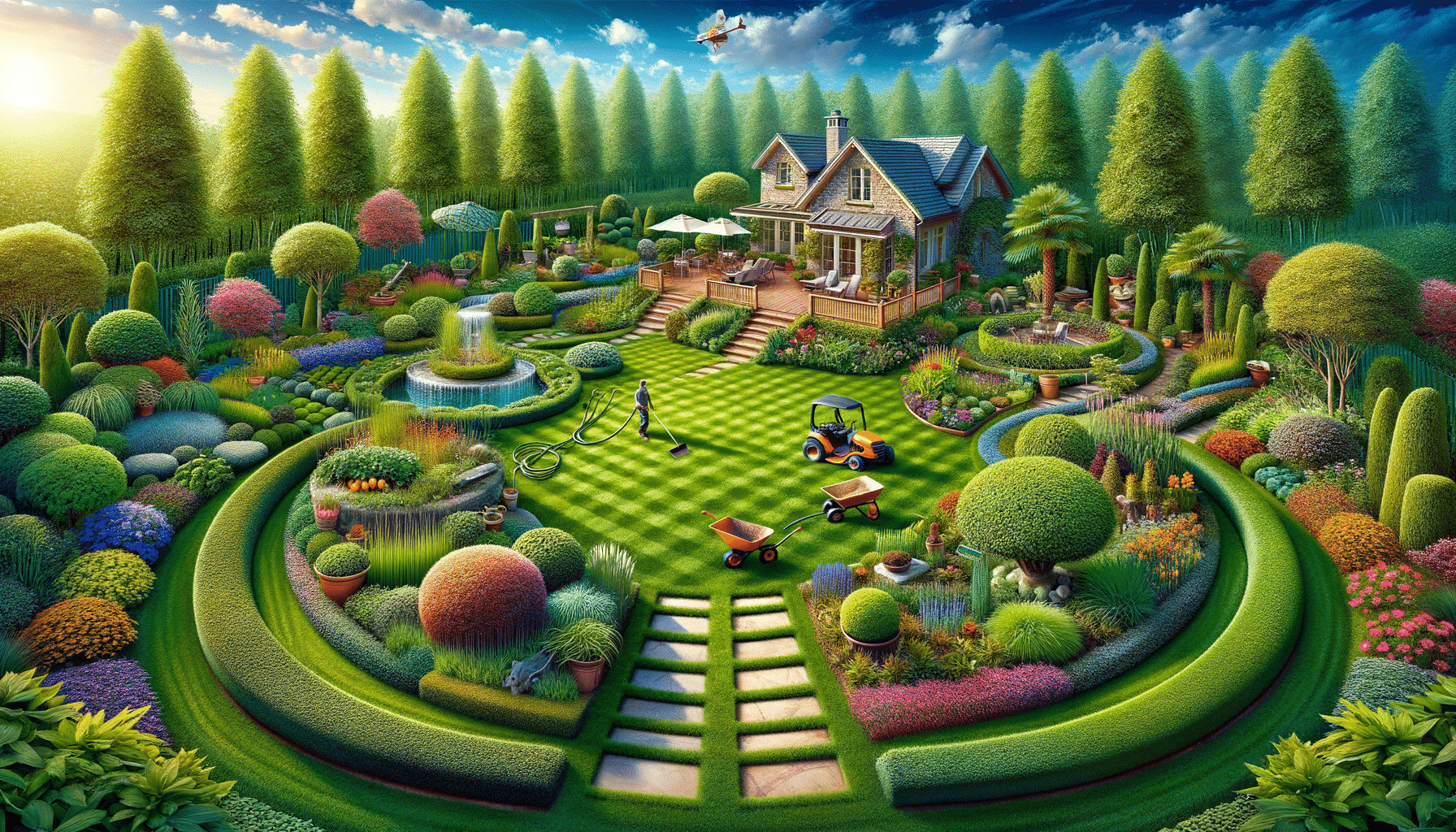
Mastering Lawn Care: Essential Tips for Year-Round Maintenance, Landscaping Basics, and Creating a Healthy, Vibrant Yard
Lawn Care: The Foundation of a Thriving Yard
Lawn care is the cornerstone of a beautiful and healthy yard. It encompasses a range of activities aimed at promoting the growth and vitality of grass. The primary elements of lawn care include mowing, watering, fertilizing, and pest control. Each of these tasks requires careful attention to detail and timing to ensure optimal results.
Mowing is more than just cutting grass; it’s about maintaining the right height to encourage healthy growth. The ideal height varies depending on the grass species, but a general rule is to never remove more than one-third of the grass blade in a single mow. This practice helps prevent stress and promotes a lush, green appearance.
Watering is another crucial aspect. The frequency and amount of water needed depend on the climate, soil type, and grass species. Generally, lawns require about one inch of water per week, either from rainfall or supplemental irrigation. Deep, infrequent watering encourages deep root growth, making the lawn more resilient to drought.
Fertilizing provides essential nutrients that grass needs to thrive. A balanced fertilizer applied at the right times during the growing season can significantly enhance the lawn’s health. It’s important to follow the manufacturer’s instructions to avoid over-fertilization, which can harm the grass and the environment.
Pest control is also vital. Regular monitoring for signs of pests, such as brown patches or chewed grass blades, can help catch infestations early. Integrated pest management strategies, which combine cultural, biological, and chemical methods, offer effective solutions while minimizing environmental impact.
Lawn Maintenance: Keeping Your Yard in Top Shape
Routine lawn maintenance is essential to keeping your yard looking its best throughout the year. Maintenance tasks include seasonal cleanup, aeration, dethatching, and overseeding. Each of these practices plays a role in maintaining a healthy and attractive lawn.
Seasonal cleanup involves removing debris, such as leaves and fallen branches, which can smother grass and create an environment conducive to pests and diseases. A thorough cleanup in the spring and fall prepares the lawn for the growing season and winter dormancy, respectively.
Aeration involves perforating the soil with small holes to allow air, water, and nutrients to penetrate the grass roots. This process helps alleviate soil compaction, which can restrict root growth and lead to poor grass health. Aeration is typically performed in the fall or spring, depending on the grass type.
Dethatching removes the layer of dead grass and roots, known as thatch, that can accumulate on top of the soil. A thin layer of thatch is normal, but excessive thatch can prevent water and nutrients from reaching the soil. Dethatching can be done manually with a rake or with a specialized machine.
Overseeding involves spreading grass seed over an existing lawn to fill in bare spots and improve density. This practice is particularly beneficial for lawns that have suffered from disease, drought, or heavy foot traffic. The best time to overseed is during the grass’s active growing season, ensuring the seeds have the best chance to germinate and establish.
Landscaping: Designing a Beautiful and Functional Yard
Landscaping is the art and science of designing outdoor spaces to enhance their aesthetic and functional appeal. It involves selecting and arranging plants, hardscapes, and other features to create a cohesive and inviting environment. Successful landscaping requires careful planning and consideration of various factors, including climate, soil conditions, and personal preferences.
One of the first steps in landscaping is assessing the site. This includes analyzing the soil type, drainage patterns, and sun exposure. Understanding these elements helps in selecting the right plants and materials that will thrive in the specific conditions of the yard.
Choosing plants is a critical aspect of landscaping. Native plants are often a smart choice, as they are well-adapted to the local climate and require less maintenance. Additionally, selecting a mix of trees, shrubs, and perennials can provide year-round interest and support local wildlife.
Incorporating hardscapes, such as patios, walkways, and retaining walls, adds structure and functionality to the yard. These elements can define spaces, create visual interest, and improve the usability of the outdoor area. It’s important to choose materials that complement the overall design and are durable enough to withstand the local climate.
Finally, consider the maintenance requirements of the landscape design. A well-planned landscape should be manageable and sustainable, reducing the need for excessive watering, pruning, or fertilization. Thoughtful planning and design can result in a beautiful outdoor space that enhances the home’s curb appeal and provides a peaceful retreat for relaxation and enjoyment.
Seasonal Lawn Care: Adapting to Nature’s Rhythms
Understanding the seasonal needs of your lawn is essential for maintaining its health and appearance throughout the year. Each season presents unique challenges and opportunities for lawn care, requiring adjustments in practices to align with the changing weather and growth patterns.
In spring, the focus is on rejuvenation. As the grass begins to grow actively, it’s time to clean up any debris left from winter, apply a balanced fertilizer, and start a regular mowing schedule. Aeration and overseeding can also be beneficial during this time to promote strong growth and fill in any bare patches.
Summer brings the challenge of heat and potential drought. It’s crucial to adjust watering practices to ensure the lawn receives enough moisture without overwatering. Mowing should be done at a higher height to provide shade for the roots and reduce stress on the grass.
Fall is an ideal time to prepare the lawn for the coming winter. Aeration and fertilization are key tasks, as they help strengthen the grass’s root system. Removing fallen leaves and thatch ensures the grass has access to sunlight and air. Fall is also a good time to overseed, as the cooler temperatures and increased rainfall create favorable conditions for seed germination.
Winter requires minimal lawn care, but some attention is still necessary. Avoid heavy foot traffic on frozen grass, as it can cause damage. If snow accumulates, try to spread it evenly to prevent compacted areas. Planning for the upcoming spring season can also be done during this time, ensuring you’re ready to hit the ground running when the weather warms up.
Sustainable Lawn Care Practices
Embracing sustainable lawn care practices is not only beneficial for the environment but can also lead to a healthier and more resilient lawn. Sustainable practices focus on reducing resource consumption, minimizing chemical use, and promoting biodiversity.
One of the key aspects of sustainable lawn care is reducing water usage. Implementing efficient irrigation systems, such as drip irrigation or soaker hoses, can significantly cut down on water waste. Additionally, choosing drought-resistant grass varieties and allowing the lawn to go dormant during dry periods can further conserve water.
Minimizing chemical inputs is another important consideration. Organic fertilizers and natural pest control methods can provide effective solutions without the negative environmental impacts associated with synthetic chemicals. Composting grass clippings and leaves can also enrich the soil naturally, reducing the need for additional fertilizers.
Promoting biodiversity within the lawn and surrounding landscape can enhance its ecological value. Incorporating native plants, creating habitats for beneficial insects, and reducing lawn size in favor of diverse planting beds can create a more balanced and sustainable ecosystem.
Overall, sustainable lawn care practices not only protect the environment but can also lead to cost savings and a more enjoyable outdoor space. By making thoughtful choices and adopting eco-friendly techniques, homeowners can maintain beautiful lawns that are in harmony with nature.


